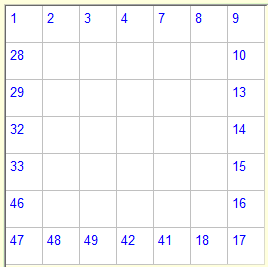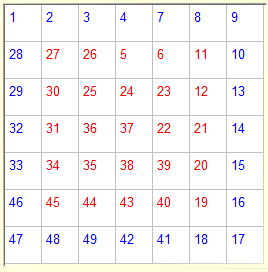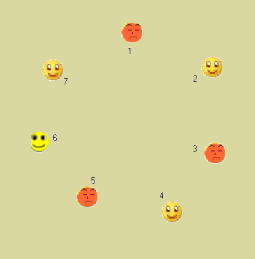What's New - October, 2008
[Home]
 |
 |
|
A Numbrix Puzzle |
Solved! |
October 21, 2008: I try to average posting a new program or version each week. Other chores have limited my spare time this week, but yesterday's "Puzzler" from the PBR radio show, "Cartalk", came to the rescue with a problem that could be solved in a couple of hours of programming. It would probably take less than that to solve it manually, but programming is more fun! Here's the puzzle:
Sally invited 17 guests to a dance party at her estate in the Hamptons. She assigned each guest a number from 2 to 18, keeping 1 for herself. At one point in the evening, Sally noticed the sum of each couple's numbers was a perfect square. Everyone was wearing their numbers on their clothing. The question is, what was the number of Sally's partner?
Go to the Perfect Square Dance page to download the source or executable that solves the problem or to read about my approach to solving it.

October 16, 2008: The "Josephus problem" requires that the player position himself so that he is last selected in a circle of N soldiers when every Kth "soldier" is eliminated starting the count at some known position 1. Josephus Version 2, posted today, adds the ability to solve the inverse problem. The final position is known along with N and K, and we must calculate where to begin the count for the selection process.
(Left: To make position 6 the final selection in a circle of
7 Smileys when selecting every 4th, start counting at position 5. So
far numbers 1, 5, and 3 have been eliminated. in that order The rest of the
elimination sequence is 2, 4, 7, and 6.)
October 9, 2008: Last week's Numbrix™ posting led to this week's project, a Numbrix™ Puzzle Generator. This link is to the Numbrix™ page; the generator is available a a separate download links at the bottom of the page. The program implements a "connect the dots" generator which finds random paths connecting all points in a square array with all turns at right angles and no crossings. By numbering the dots and pre-defining those to be shown a clues, a file can be saved in the format expected by our Numbrix™ solver.
October 4, 2008: Here's an update to our program that calculates the shortest distance between two given points on the earth's surface. Lat-Long Distance Version 2 adds an implementation of Vincenty's algorithm (Vincenty's Inverse) that calculates distances with an error of less than 0.001 inch! More significantly, the program also implements the original version of the algorithm (Vincenty's Direct) that calculates end point coordinates for a great circle route given a point together with an initial bearing and a distance.
